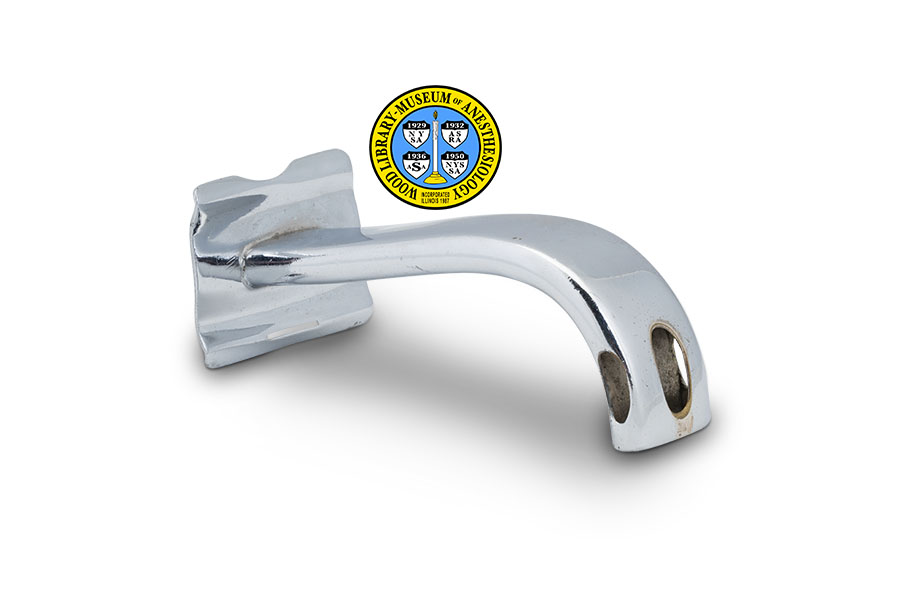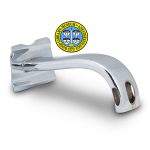Roberts Airway
An artificial airway acts as a tongue depressor while providing a conduit for air and gases moving into and out of the patient. British gynecologist, Dr. William Blair Bell (1871-1936), of Liverpool, was the founding President of the Royal College of Obstetricians and Gynaecologists. He invented several medical instruments, including an oropharyngeal airway. It was first described in 1916, by his colleague, Dr. Mona Dew Roberts (1878-1936). Because of this, it has always been known by her name.
Dr. Roberts stated that Dr. Blair Bell's tube was a modification of one used in the United States; this was probably either the Connell airway (introduced in 1912) or the Flagg airway (introduced in 1916.) A distinctive feature of the Roberts airway is an upright flange that is rippled rather than flat, and has a crescent-shaped notch in the top edge to accommodate the patient's nose. The Roberts airway was made by several different instrument companies and was still available as late as the 1970s.
Catalog Record: Roberts Airway Roberts Airway
Access Key: apol
Accession No.: 1998-12-30-2 M
Title: [Roberts airway].
Author: Blair Bell, William, 1871-1936.
Author: Roberts, Mona Dew, 1878-1936.
Corporate Author: Mayer & Co.
Title variation: Alt Title
Title: Roberts oral tube.
Title variation: Alt Title
Title: Blair Bell airway.
Publisher: London : Mayer & Co., [between 1911 and 1970?].
Physical Description: 1 airway : metal ; 3.25 x 9 x 4.75 cm.
Subject: Airway Management – instrumentation.
Subject: Anesthesia, Inhalation – instrumentation.
Subject: Oropharyngeal Airway Devices.
Web Link: https://www.woodlibrarymuseum.org/museum/item/1062/roberts-airway
Note Type: General
Notes: The first year in the date range is that in which the airway was first described. The second year in the date range is based on the approximate date of the latest publication in which it was found. The maker’s mark is considerably older than the earliest possible date of manufacture. Successor companies retained the name “Mayer” until 1979, when the firm was acquired by Down Brothers; the object is likely to have been made somewhat earlier.
Note Type: Citation
Notes: Allen & Hanburys. Anaesthetic Apparatus and Oxygen Apparatus. London: Allen & Hanburys Ltd., 1938:45.
Note Type: Citation
Notes: British Medical Journal. [Obituary]. May 2, 1936;1(3930):919-920.
Note Type: Citation
Notes: Blair Bell W. The Principles of Gynaecology. London: Longmans, Green and Co., 1910.
Note Type: Citation
Notes: Blair Bell WEschmann. Surgical Instruments. England: Eschmann, ca. 1970. The Principles of Gynaecology, 3rd ed. New York: William Wood & Co., 1919:499.
Note Type: Citation
Notes: downs-surgical.com. Accessed May 27, 2009.
Note Type: Citation
Notes: Eschmann. Surgical Instruments. England: Eschmann, ca. 1970.
Note Type: Citation
Notes: Frost, Phillida. Yet another airway. History of Anaesthesia Society Proceedings. June 25-26, 1993;13:12-14.
Note Type: Citation
Notes: Mayer & Meltzer. Illustrated Catalogue of Surgical Instruments and Appliances. London: Mayer & Meltzer, 1899.
Note Type: Citation
Notes: Mayer & Phelps. An Illustrated Catalogue of Surgical Instruments and Appliances. London: Mayer & Phelps, 1931.
Note Type: Citation
Notes: Roberts MD. An oral tube in open ether anaesthesia. Lancet. December 23, 1916;188(4869):1060.
Note Type: Citation
Notes: https://www.rcog.org.uk/en/about-us/history-of-the-college/presidents-of-the-rcog/. Accessed December 20, 2016.
Note Type: Physical Description
Notes: One airway; Consists of a flattened metal tube, shaped in a shallow S-curve; It is open at both ends, with an upright flange at the distal end; The tube is approximately 2 centimeters wide, with a diameter of half a centimeter; There are three additional openings at the proximal end (one in the top and one on each side of the tube); The flange is rippled rather than flat, and has a crescent-shaped notch in the center of its upper edge; The back of this flange is marked “MAYER & CO.”
Note Type: Reproduction
Notes: Photographed by Mr. Steve Donisch, November 15, 2016.
Note Type: Historical
Notes: An artificial airway provides a conduit for air and anesthetic gases passing to and from the patient; it also helps keep the patient’s tongue out of the way. The first modern artificial airway was introduced by Hewitt in 1908. Many other designs soon followed.
British gynecologist, Dr. William Blair Bell (1871-1936), of Liverpool, invented several medical instruments. One of these was an oropharyngeal airway. It appears in the third edition of his textbook, The Principles of Gynaecology (1919), and was manufactured by the Liverpool instrument maker, Alexander & Fowler. The illustration shows a row of upright bars across that opening which is proximal to the anesthesiologist. These bars might indicate the presence of a bite block. This airway does not appear, nor is the use of any airway mentioned, in the first edition of Blair Bell’s textbook (1910). The cataloger could not obtain a copy of the second edition (1917). Nor has the cataloger found Blair Bell’s airway by that name in any other publication. Dr. Blair Bell went on to become the founding President of the Royal College of Obstetricians and Gynaecologists in 1929.
The first description of his airway appears to have been published in 1916 by British physician Mona Dew Roberts (1878-1936.) Somewhat confusingly, she stated: “For the past nine months I have been using an oral tube for the administration of open ether in all gynaecological surgeries performed by Dr. W. Blair Bell at the Liverpool Royal Infirmary, and its use has been so uniformly advantageous that I am anxious to bring it to the notice of the medical profession. The tube is modelled upon one in use in the United States and by Dr. Mott of Stoke, and has been modified by Dr. Blair Bell, who first suggested its use to me.” The accompanying illustration appears to be identical to that in Blair Bell’s 3rd edition, except that no upright bars are visible.
The tube that Dr. Roberts states was used in the United States might have been either the Connell airway
(introduced in 1912) or the Flagg airway (introduced in 1916), both of which have features in common with Blair Bell’s airway. All three consist of a metal S-curve, with am upright flange at the end that is proximal to the anesthesiologist and with openings in the top as well as on either side of the end that is distal to the anesthesiologist. The distinctive feature of Blair Bell’s airway is a rippled flange; this has a crescent-shaped notch in the top edge to accommodate the patient’s nose. This design appears in various publications in the WLM collection dating from 1922 through approximately 1970. In all of these it is called the “Roberts'” or “Mona Roberts’” airway.
The cataloged object is marked “Mayer & Co.” It is likely that this mark belongs to the company that was first known as Joseph Mayer, established by 1863. In 1866 this became Mayer & Meltzer, and in 1919 it became Mayer & Phelps. By 1979, it had been acquired by Down Brothers, another London instrument company. In the 1931 Mayer & Phelps catalog, the illustrations of airway management devices, including the Roberts Airway, are marked “Mayer, London”. Although Dr. Roberts’ 1916 description of the airway did not mention an attachment, several catalogs offered this airway with a removable anesthetic tube or “nipple”. The cataloged object does not have such a nipple.
Note Type: Publication
Notes: Blair Bell W. The Principles of Gynaecology, 2nd ed. London: Bailliere, Tindall & Cox, 1917.
Note Type: Exhibition
Notes: Selected for the WLM website.


